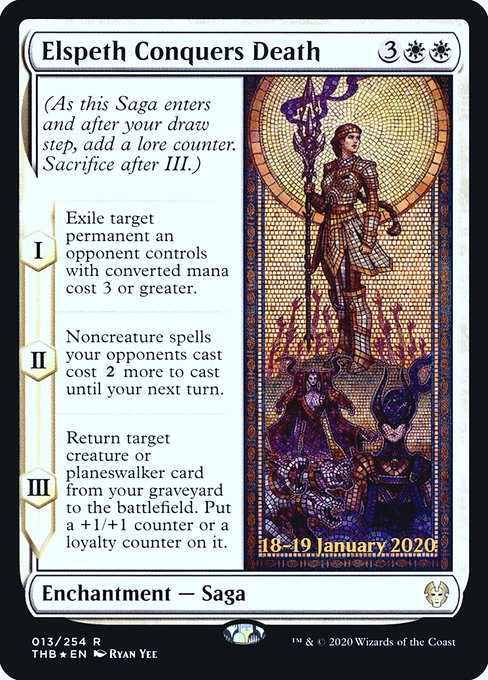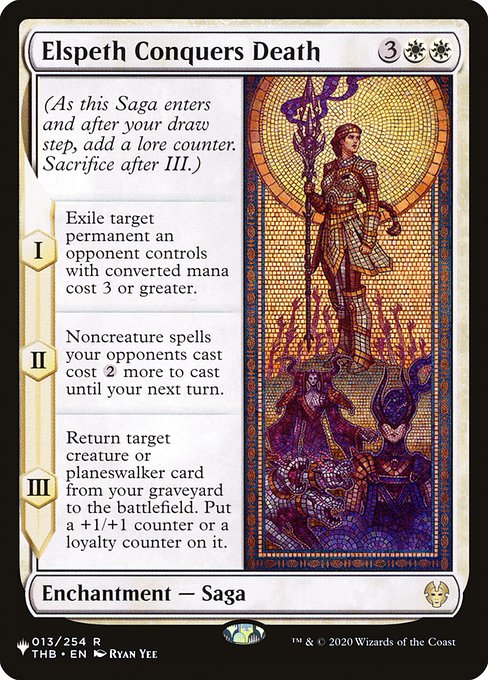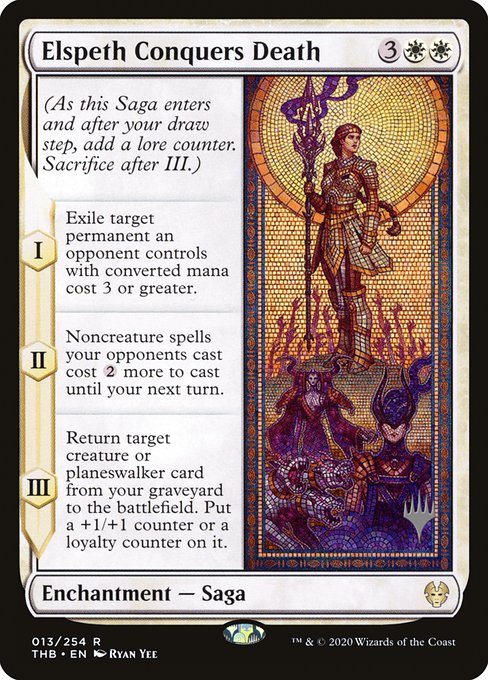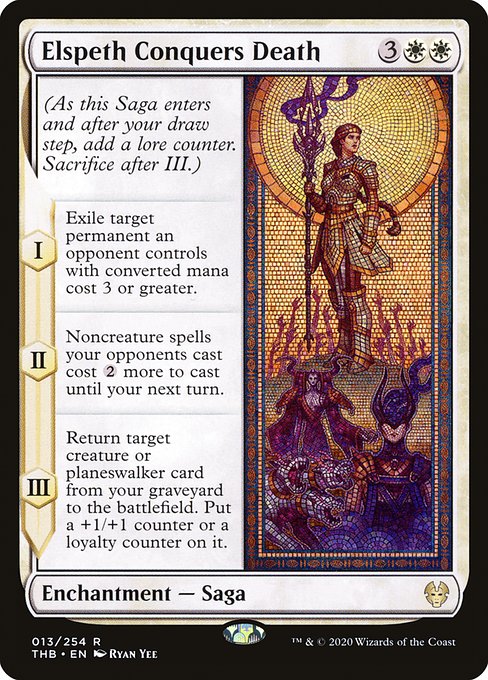Elspeth Conquers Death
Enchantment — Saga
(As this Saga enters and after your draw step, add a lore counter. Sacrifice after III.)
I — Exile target permanent an opponent controls with mana value 3 or greater.
II — Noncreature spells your opponents cast cost more to cast until your next turn.
III — Return target creature or planeswalker card from your graveyard to the battlefield. Put a +1/+1 counter or a loyalty counter on it.
I — Exile target permanent an opponent controls with mana value 3 or greater.
II — Noncreature spells your opponents cast cost more to cast until your next turn.
III — Return target creature or planeswalker card from your graveyard to the battlefield. Put a +1/+1 counter or a loyalty counter on it.
standard
future
historic
gladiator
pioneer
explorer
modern
legacy
pauper
vintage
penny
commander
brawl
alchemy
paupercommander
duel
oldschool
premodern
Rulings
You choose which kind of counter to put on the returned permanent after it has entered the battlefield. You may put a +1/+1 counter on a planeswalker or a loyalty counter on a creature, but this isn’t normally going to have any effect.
In a multiplayer game, if you leave the game after this Saga’s second chapter ability resolves but before your next turn begins, its effect lasts until your next turn would have begun. It neither expires immediately nor lasts indefinitely.
Each symbol on the left of a Saga’s text box represents a chapter ability. A chapter ability is a triggered ability that triggers when a lore counter that is put on the Saga causes the number of lore counters on the Saga to become equal to or greater than the ability’s chapter number. Chapter abilities are put onto the stack and may be responded to.
As a Saga enters the battlefield, its controller puts a lore counter on it. As your precombat main phase begins (immediately after your draw step), you put another lore counter on each Saga you control. Putting a lore counter on a Saga in either of these ways doesn’t use the stack.
Once a chapter ability has triggered, the ability on the stack won’t be affected if the Saga gains or loses counters, or if it leaves the battlefield.
Removing lore counters won’t cause a previous chapter ability to trigger. If lore counters are removed from a Saga, the appropriate chapter abilities will trigger again when the Saga receives lore counters.
The effect of the second chapter lasts until your next turn even if this Saga leaves the battlefield before then.
To determine the total cost of a spell, start with the mana cost or alternative cost you’re paying, add any cost increases (such as that of this Saga’s second chapter), then apply any cost reductions. The converted mana cost of the spell remains unchanged, no matter what the total cost to cast it was.
Once the number of lore counters on a Saga is greater than or equal to the greatest number among its chapter abilities, the Saga’s controller sacrifices it as soon as its chapter ability has left the stack, most likely by resolving or being countered. This state-based action doesn’t use the stack.
If a creature on the battlefield has in its mana cost, X is considered to be 0.
A chapter ability doesn’t trigger if a lore counter is put on a Saga that already had a number of lore counters greater than or equal to that chapter’s number. For example, the third lore counter put on a Saga causes the III chapter ability to trigger, but I and II won’t trigger again.
If multiple chapter abilities trigger at the same time, their controller puts them on the stack in any order. If any of them require targets, those targets are chosen as you put the abilities on the stack, before any of those abilities resolve.
In a multiplayer game, if you leave the game after this Saga’s second chapter ability resolves but before your next turn begins, its effect lasts until your next turn would have begun. It neither expires immediately nor lasts indefinitely.
Each symbol on the left of a Saga’s text box represents a chapter ability. A chapter ability is a triggered ability that triggers when a lore counter that is put on the Saga causes the number of lore counters on the Saga to become equal to or greater than the ability’s chapter number. Chapter abilities are put onto the stack and may be responded to.
As a Saga enters the battlefield, its controller puts a lore counter on it. As your precombat main phase begins (immediately after your draw step), you put another lore counter on each Saga you control. Putting a lore counter on a Saga in either of these ways doesn’t use the stack.
Once a chapter ability has triggered, the ability on the stack won’t be affected if the Saga gains or loses counters, or if it leaves the battlefield.
Removing lore counters won’t cause a previous chapter ability to trigger. If lore counters are removed from a Saga, the appropriate chapter abilities will trigger again when the Saga receives lore counters.
The effect of the second chapter lasts until your next turn even if this Saga leaves the battlefield before then.
To determine the total cost of a spell, start with the mana cost or alternative cost you’re paying, add any cost increases (such as that of this Saga’s second chapter), then apply any cost reductions. The converted mana cost of the spell remains unchanged, no matter what the total cost to cast it was.
Once the number of lore counters on a Saga is greater than or equal to the greatest number among its chapter abilities, the Saga’s controller sacrifices it as soon as its chapter ability has left the stack, most likely by resolving or being countered. This state-based action doesn’t use the stack.
If a creature on the battlefield has in its mana cost, X is considered to be 0.
A chapter ability doesn’t trigger if a lore counter is put on a Saga that already had a number of lore counters greater than or equal to that chapter’s number. For example, the third lore counter put on a Saga causes the III chapter ability to trigger, but I and II won’t trigger again.
If multiple chapter abilities trigger at the same time, their controller puts them on the stack in any order. If any of them require targets, those targets are chosen as you put the abilities on the stack, before any of those abilities resolve.
Rulings
You choose which kind of counter to put on the returned permanent after it has entered the battlefield. You may put a +1/+1 counter on a planeswalker or a loyalty counter on a creature, but this isn’t normally going to have any effect.
In a multiplayer game, if you leave the game after this Saga’s second chapter ability resolves but before your next turn begins, its effect lasts until your next turn would have begun. It neither expires immediately nor lasts indefinitely.
Each symbol on the left of a Saga’s text box represents a chapter ability. A chapter ability is a triggered ability that triggers when a lore counter that is put on the Saga causes the number of lore counters on the Saga to become equal to or greater than the ability’s chapter number. Chapter abilities are put onto the stack and may be responded to.
As a Saga enters the battlefield, its controller puts a lore counter on it. As your precombat main phase begins (immediately after your draw step), you put another lore counter on each Saga you control. Putting a lore counter on a Saga in either of these ways doesn’t use the stack.
Once a chapter ability has triggered, the ability on the stack won’t be affected if the Saga gains or loses counters, or if it leaves the battlefield.
Removing lore counters won’t cause a previous chapter ability to trigger. If lore counters are removed from a Saga, the appropriate chapter abilities will trigger again when the Saga receives lore counters.
The effect of the second chapter lasts until your next turn even if this Saga leaves the battlefield before then.
To determine the total cost of a spell, start with the mana cost or alternative cost you’re paying, add any cost increases (such as that of this Saga’s second chapter), then apply any cost reductions. The converted mana cost of the spell remains unchanged, no matter what the total cost to cast it was.
Once the number of lore counters on a Saga is greater than or equal to the greatest number among its chapter abilities, the Saga’s controller sacrifices it as soon as its chapter ability has left the stack, most likely by resolving or being countered. This state-based action doesn’t use the stack.
If a creature on the battlefield has in its mana cost, X is considered to be 0.
A chapter ability doesn’t trigger if a lore counter is put on a Saga that already had a number of lore counters greater than or equal to that chapter’s number. For example, the third lore counter put on a Saga causes the III chapter ability to trigger, but I and II won’t trigger again.
If multiple chapter abilities trigger at the same time, their controller puts them on the stack in any order. If any of them require targets, those targets are chosen as you put the abilities on the stack, before any of those abilities resolve.
In a multiplayer game, if you leave the game after this Saga’s second chapter ability resolves but before your next turn begins, its effect lasts until your next turn would have begun. It neither expires immediately nor lasts indefinitely.
Each symbol on the left of a Saga’s text box represents a chapter ability. A chapter ability is a triggered ability that triggers when a lore counter that is put on the Saga causes the number of lore counters on the Saga to become equal to or greater than the ability’s chapter number. Chapter abilities are put onto the stack and may be responded to.
As a Saga enters the battlefield, its controller puts a lore counter on it. As your precombat main phase begins (immediately after your draw step), you put another lore counter on each Saga you control. Putting a lore counter on a Saga in either of these ways doesn’t use the stack.
Once a chapter ability has triggered, the ability on the stack won’t be affected if the Saga gains or loses counters, or if it leaves the battlefield.
Removing lore counters won’t cause a previous chapter ability to trigger. If lore counters are removed from a Saga, the appropriate chapter abilities will trigger again when the Saga receives lore counters.
The effect of the second chapter lasts until your next turn even if this Saga leaves the battlefield before then.
To determine the total cost of a spell, start with the mana cost or alternative cost you’re paying, add any cost increases (such as that of this Saga’s second chapter), then apply any cost reductions. The converted mana cost of the spell remains unchanged, no matter what the total cost to cast it was.
Once the number of lore counters on a Saga is greater than or equal to the greatest number among its chapter abilities, the Saga’s controller sacrifices it as soon as its chapter ability has left the stack, most likely by resolving or being countered. This state-based action doesn’t use the stack.
If a creature on the battlefield has in its mana cost, X is considered to be 0.
A chapter ability doesn’t trigger if a lore counter is put on a Saga that already had a number of lore counters greater than or equal to that chapter’s number. For example, the third lore counter put on a Saga causes the III chapter ability to trigger, but I and II won’t trigger again.
If multiple chapter abilities trigger at the same time, their controller puts them on the stack in any order. If any of them require targets, those targets are chosen as you put the abilities on the stack, before any of those abilities resolve.
Your collection? Your decks?
Want to manage your collection and/or create decks?



 0
0
 1.01€
1.01€

